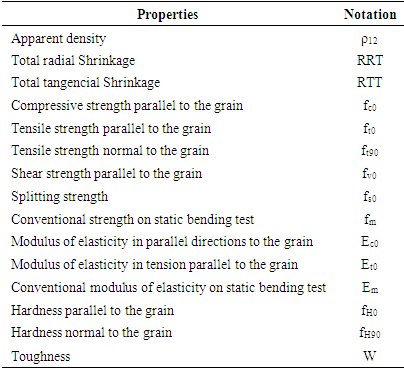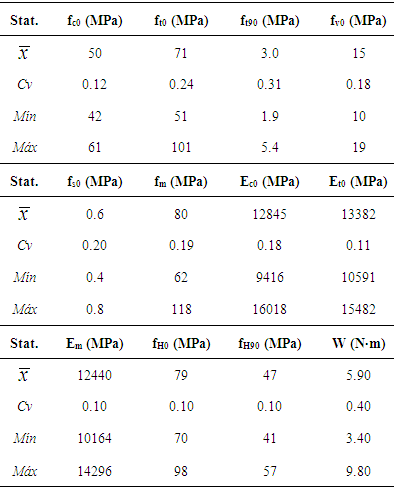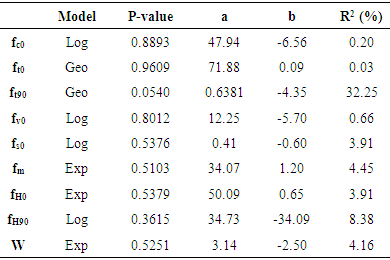Vinicius Borges de Moura Aquino1, João Paulo Boff Almeida2, Diego Henrique de Almeida1, Tiago Hendrigo de Almeida3, Tulio Hallak Panzera4, André Luis Christoforo1, Francisco Antonio Rocco Lahr5
1Department of Civil Engineering (DECiv), Federal University of São Carlos (UFSCar), São Carlos, Brazil
2Department of Civil Engineering, University of Mato Grosso State (UNEMAT), Sinop, Brazil
3Department of Science and Material Engineering, São Carlos Engineering School (SMM), São Carlos, Brazil
4Centre for Innovation and Technology in Composites (CITeC), Department of Mechanical Engineering, Federal University of São João del-Rei, São João del-Rei, Brazil
5Department of Structural Engineering (SET), São Carlos Engineering School, São Paulo University (EESC/USP), São Carlos, Brazil
Correspondence to: André Luis Christoforo, Department of Civil Engineering (DECiv), Federal University of São Carlos (UFSCar), São Carlos, Brazil.
| Email: |  |
Copyright © 2018 The Author(s). Published by Scientific & Academic Publishing.
This work is licensed under the Creative Commons Attribution International License (CC BY).
http://creativecommons.org/licenses/by/4.0/

Abstract
Wood has been used by mankind for many years in many purposes specially in construction and manufacture. It is necessary to characterize unknown species as an alternative for human use due to predatory harvest of well-known wood species; in consequence, possible shortage of this wood. This study intended to determine, under the Brazilian Standard ABNT NBR 7190, the mechanical properties of Copaíba wood (Copaifera sp.), and with the analysis of variance (ANOVA), handling the regression models, predict the values of strength and stiffness as a function of apparent density. Twelve models were used for each test, totalizing 180 experimental results. The mechanical properties of Copaifera sp. presented on tests demonstrated compatible performance with common wood species used in civil construction. According the regression models, any properties were considered significant with apparent density estimation.
Keywords:
Characterization, Copaifera sp., Regression model, Analysis of variance (ANOVA)
Cite this paper: Vinicius Borges de Moura Aquino, João Paulo Boff Almeida, Diego Henrique de Almeida, Tiago Hendrigo de Almeida, Tulio Hallak Panzera, André Luis Christoforo, Francisco Antonio Rocco Lahr, Physical and Mechanical Characterization of Copaifera sp. Wood Specie, International Journal of Materials Engineering , Vol. 8 No. 3, 2018, pp. 55-58. doi: 10.5923/j.ijme.20180803.03.
1. Introduction
The use of wood in manufacture and construction is a practice performed for many years since human being needed to overcome their want, since store food to construction of shelters. Nowadays it is used in construction, paper manufacture, musical instruments, sports equipment, and wood panels. The use of wood in a large range of view implies the knowledge of its properties (physical, chemical, mechanical and anatomical) for a rational use of this material, which is a natural resource, meeting the requirements that the current environmental appeal of products and services provided by man [1-3].Despite the fact the high-level demand and few options of known wood species, predatory harvesting has reduced market receptivity for new species, whose characteristics and properties are not well known. This fact had affected the prices on market, being necessary to define which new species could replace the traditional used in buildings [1, 4]. In consequence, the Copaifera sp. becomes a great option, especially to Amazonian part of Brazil, the west and southeast part of Brazilian country, where the production of this wood specie is more noticeable [5].In Brazil, wood characterization wood (which consists in determining its mechanical and physical properties by standardized tests) is based on ABNT NBR 7190, in its Annex B [6]. Nevertheless, the disadvantage of many tests is the charge to use large and expensive equipment available in research centers.Otherwise, a physical property of easy experimental determination is the apparent density, defined by the ratio between the mass and volume of the sample at 12% moisture. Considering that density is a basic physical property, its values endorse determining an appropriate estimate of some wood properties [1, 7, 8, 9]. The estimation of strength and stiffness properties by density via mathematical methods (regression methods) enables the engineer a better pre-design of the structure.In order to contribute to the use of new wood species in rural and civil construction, as well as other applications, this study aimed to characterize the Copaifera sp. wood specie and evaluate the possibility of estimating strength and stiffness properties investigated by the apparent density.
2. Material and Methods
The wood samples of the Copaifera sp. has been properly stored, with close to 12% moisture content, and this is the moisture balance established by the Brazilian standard [6].All tests were carried out on the Laboratory of Wood and Wood Structures (Laboratório de Madeiras e de Estruturas de Madeira - LaMEM), Department of Structural Engineering (SET), São Carlos Engineering School (EESC), University of São Paulo (USP).The physical and mechanical properties (Table 1) were obtained according to the assumptions and calculation methods given by ABNT NBR 7190 [6] (Timber Structures Design), provided on its Annex B. It should be noted that 12 values for each one of its physical (3) and mechanical properties (12) were investigated, resulting in 180 experimental values obtained.In addition to obtaining the physical and mechanical properties listed in Table 1, the wood Copaifera sp. has been properly classified in the timber strength classes [6], defined by determining its characteristic value of compressive strength parallel to the grain (fc0,k).Table 1. Mechanical and physical properties measured for the Copaifera sp. wood specie
 |
| |
|
To estimate the strength and the stiffness properties (Y), as a function of the apparent density (ρ12) of the Copaifera sp. wood specie, regression models were used (Equations 1 to 4) based on analysis of variance (ANOVA), tested in a way to establish the best fit for estimated property. | (1) |
 | (2) |
 | (3) |
 | (4) |
By ANOVA regression models, considering the 5% level of significance (α), the formulated null hypothesis consisted by the non-representativeness of the tested models (H0: β = 0), and the representativeness as an alternative hypothesis (H1: β ≠ 0). P-value greater than the significance level implies in the accepting H0 (the model tested is not representative - ρ12 variations are unable to explain the variation in strength and stiffness property), refuting it otherwise (the model tested is representative).Besides the use of ANOVA (which allows to accept or not the representativeness of the tested models), the coefficient of determination values (R2) were obtained as a way to evaluate the variation capability in the apparent density to explain the estimated dependent variable. Thus, it is possible to determine, among the considered significant models (4 models for each of the 12 strength properties and estimated stiffness – resulting in 48 adjustments), the ones with best fit.
3. Results and Discussion
Tables 2 and 3 shows the mean values  coefficient of variation (Cv), the lowest (Min) and the highest (Max) of the physical and mechanical properties of the Copaifera sp. wood, respectively.
coefficient of variation (Cv), the lowest (Min) and the highest (Max) of the physical and mechanical properties of the Copaifera sp. wood, respectively.Table 2. Physical properties results for the Copaifera sp. wood
 |
| |
|
Table 3. Mechanical properties results for the Copaifera sp. wood
 |
| |
|
With the value of the characteristic compression parallel to grain, based on the Brazilian Standard ABNT NBR 7190 [6], Copaifera sp. fits to the C40 strength class. The value fc0 (50 MPa) is close to the study developed by Dias and Lahr (50 MPa) [2] for Copaifera sp, and Amescla-Aroeira wood (59.03 MPa) [10], indicating the chance of use of Copaifera sp. wood in structures of medium dimensions.Comparing the value obtained (fc0) with Paricá wood (24 MPa) [11], Toona ciliata (27 MPa) [12] and Eucalyptus bentamii Maiden et Cambage (37.34 MPa) [13], Copaifera sp. strength in compression parallel to grain (50 MPa) is higher than the species had already described, woods with potential for use in construction [1].The mean value obtained from apparent density of 0.70 g/cm³ classifies Copaifera sp. as a heavy wood [14], in the same class of Lecythis poiteaui, Mezilaurus itauba, Minquartia guianensis, Manikara huberi and Brosimum rubescens [15] but lighter than the species indicated, with density ranged from 0.835 to 0.904 g/cm³ for the referred species. Comparing with Liquidambar sp. [16], Pinus and Teca [7], Cedrela fissilis and Hovenia dulcis [15], whose density varying between 0.478 and 0.577 g/cm³, Copaifera sp. wood apparent density (ρ12) is higher than this wood species. The softwoods, such as Toona ciliata [13], Paricá [11] and Gallesia integrifolia [17] contain density between 0.318 g/cm³ and 0.370 g/cm³.Brazilian Standard ABNT NBR 7190 [6] defines the maximum value for the coefficient of variation (Cv) for the characterization to be considered as adequate, being 18% for strength in normal stresses and 28% for tangential efforts. All properties met the values of the coefficients of variation required by the standard, but the tensile strength norma to the grain (ft90), the conventional strength on static bending test (fm) and toughness (W), which exceed the limit, showing a Cv equal to 0.33, 0.19 and 0.40, respectively.Tables 4 and 5 shows the best fits (by property) obtained using regression models for apparent density in the estimation of the values of strength and stiffness, respectively.Table 4. Regression models for the strength values estimation of the Copaifera sp. by the apparent density
 |
| |
|
Table 5. Regression models for the stiffness values estimation of the Copaifera sp. by the apparent density
 |
| |
|
Considering the adjustments in Table 4, any property can be estimated by the apparent density, indicating the non-represntativeness of the apparent density as an estimator of strength and stiffness properties. It must be pointed out that Lahr et al. [18] found no relation between apparent density and strength and stiffness properties.
4. Conclusions
The results of this study permit us to conclude:- Following the disposed Brazilian Code, Copaifera sp. is classified as C40 strength class due to its characteristic value of compressive strength, implying a potential performance in manufacture and constructions, including structural performance.- According the values of the adjustments, the regression models were not able to estimate strength and stiffness properties as a function of apparent density.
ACKNOWLEDGMENTS
For all the provided support, the authors thanks the Coordenação de Aperfeiçoamento de Nível Superior (CAPES) and the Conselho Nacional de Desenvolvimento Científico e Tecnológico (CNPq).
References
| [1] | Christoforo, A. L.; Arroyo, F. N.; Silva, D. A. L.; Panzera, T. H.; Lahr, F. A. R. Full Characterization of Calycophyllum Multiflorum wood specie. Journal of the Brazilian Association of Agricultural Engineering, Jaboticabal-SP, v.37, n.4, p. 637-643, jul/ago, 2017. |
| [2] | Dias, F. M.; Lahr, F. A. R. Estimativa de Propriedades de resistência e rigidez da madeira através da densidade aparente. Revista Scientia Forestalis, Piracicaba-SP, n. 65, p. 102-113, jun, 2004. |
| [3] | Machado, J. S.; Louzada, J. L.; Santos, A. J. A.; Nunes, L.; Anjos, O.; Rodrigues, J.; Simões, R. M. S.; Pereira, H. Variation of wood density and mechanical properties of blackwood (Acacia menaloxylon R. Br.) Materials and Design, v. 56, p. 975-980, 2013. |
| [4] | Lahr, F. A. R.; Arroyo, F. N.; Almeida, T. H.; Almeida Filho, F. M.; Mendes, I. S.; Christoforo, A. L. Full Characterization of Erisma uncinatum Warm Wood Specie. Intenetional Journal of Materials Engineering 2016, 6(5): 147-150. |
| [5] | Instituto De Pesquisas Tecnológicas Do Estado De São Paulo. Madeira: uso sustentável na construção civil. São Paulo, disponível em: http://www.ipt.br/informacoes_madeiras/9.htm, acesso em: 03 de Junho de 2018. |
| [6] | Associação Brasileira De Normas Técnicas – ABNT. NBR 7190. Projeto de estruturas de madeira. Rio de Janeiro, 107 p., 1997. |
| [7] | Almeida, D. H.; Scaliante, R. M.; Christoforo, A. L.; Varanda, L. D.; Lahr, F. A. R.; Dias, A. A.; Junior, C. C. Tenacidade da madeira como função da densidade aparente, Revista Árvore, Viçosa-MG, v.38, n.1, p.203-207, 2014. |
| [8] | Almeida, D. H.; Chahud, E.; Almeida, T. H.; Christoforo, A. L.; Branco, L. A. M. N.; Lahr, F. A. R. Determination of Density, Shear and Compression Parallel to the Grain Strengths of Pariri (Pouteria sp.), Brazilian Native Wood Specie, International Journal of Materials Engineering 2015, 5(5): 109-112. |
| [9] | Komariah, R. N.; Hadi, Y. S.; Massijiaya, M. Y; Suryana, J. Physical-Mechanical Properties of Glued Laminated Timber Made from Tropical Small-Diameter Logs Grown in Indonesia. Journal of the Korean Wood Science and Tecnology, v. 43, n. 2, p. 156-167, 2015. |
| [10] | Logsdon, N. B.; Finger, Z.; Estevão, J. G. Descrição Dendrológica e caracterização físico-mecânica da madeira de Amescla-aroeira, Protium heptaphyllum (Aubl) March. (Burseraceae), Revista Madeira Arquitetura e Engenharia, ano 6, Set-Dez. 2005. |
| [11] | Almeida, D. H.; Scaliante, R. M.; Macedo, L. B.; Macêdo, A. N.; Dias, A. A.; Christoforo, A. L.; Junior, C. A. Caracterização completa da madeira da espécie amazônica Paricá (Schizolobium amazonicum HERB) em peças de dimensões estruturais, Revista Árvore, Viçosa-MG, v.37, n.6, p.1175-1181, 2013. |
| [12] | Braz, R. L.; Oliveira, J. T. S.; Rodrigues, B. P.; Arantes, M. D. C. Propriedades físicas e mecânicas da madeira de Toona ciliata em diferentes idades, FLORESTA, Curitiba, PR, v.43, n.4, p.663-670, out/dez, 2013. |
| [13] | Müller, B. V.; Rocha, M. P.; Cunha, A. B.; Klitzke, R. J.; Nicoletti, M. F. Avaliação das Principais Propriedades Físicas e Mecânicas da Madeira de Eucalyptus benthamii Maiden et Cambage, Floresta e Ambiente 2014 out./dez.; 21(4): 535-542. |
| [14] | Melo, J. E.; Coradin, V. T. R.; Mendes, J. C. Classes de densidade de madeira para a Amazônia brasileira. In: Anais do Congresso Florestal brasileiro 6:695-699. São Paulo, SP, Brasil, 1990. |
| [15] | Silveira, L. H. C.; Rezende, A. V.; Vale, A. T. Teor de umidade e densidade básica da madeira de nove espécies comerciais amazônicas, Acta Amazônica, Vol. 43(2) 2013: 179-184. |
| [16] | Freitas, T. P.; Feuchard, L. D.; Oliveira, J. T. S.; Paes, J. B.; Arantes, M. D. C. Caracterizações anatômicas e físico-mecânica da madeira de Liquidambar sp., FLORESTA, Curitiba, PR, v.45, n.4, p.723-734, out/dez, 2015. |
| [17] | Motta, J. P.; Oliveira, J. T. S.; Braz, R. L.; Duarte, A. P. C., Alves, R. C. Caracterização da madeira de quatro espécies florestais, Ciência Rural, Santa Maria, V.44, n.12, p.2186-2192, dez, 2014. |
| [18] | Lahr, F. A. R.; Arroyo, F. N.; Almeida, T. H.; Almeida Filho, F. M.; Mendes, I. S.; Christoforo, A. L. Full Characterization of Erisma uncinatum Warm Wood Specie. International Journal of Materials Engineering, v. 6, p. 147-150, 2016. |
| [19] | Montgomery, D. C. Design and analysis in experiments. Arizona: John Wiley & Sons, 2012, 730p. |







 coefficient of variation (Cv), the lowest (Min) and the highest (Max) of the physical and mechanical properties of the Copaifera sp. wood, respectively.
coefficient of variation (Cv), the lowest (Min) and the highest (Max) of the physical and mechanical properties of the Copaifera sp. wood, respectively. Abstract
Abstract Reference
Reference Full-Text PDF
Full-Text PDF Full-text HTML
Full-text HTML



